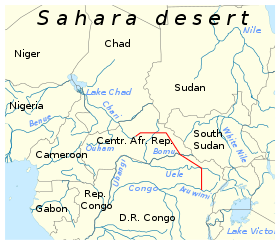Lake Chad replenishment project

The Lake Chad replenishment project is a proposed major water diversion scheme that would involve damming the Ubangi River at Palambo in Central African Republic and channeling some of the water to Lake Chad through a navigable canal.[1]
The canal was suggested by a Nigerian engineer before 1991, and would generate hydro-electricity at several points along its length. These would power new industrial townships, while the canal would replenish the lake.[2] The irrigation scheme for a 2,400 km canal from the Congo Basin to the lake, which has been steadily shrinking, was considered unlikely to materialize as late as 2005.[3]
The members of the Lake Chad Basin International Commission are Chad, the Central African Republic, Nigeria, Cameroon and Niger. Concerned by shrinkage of the lake's area from 20,000 square kilometres (7,700 sq mi) in 1972 to 2,000 square kilometres (770 sq mi) in 2002, they met in January 2002 to discuss the project. Both the ADB and the Islamic Development Bank expressed interest in the project. However, the member states of the Congo-Ubangi-Sangha Basin International Commission, Congo-Kinshasa, Congo-Brazzaville and the Central African Republic expressed concern that the project would reduce the energy potential of the Inga hydroelectric dam, would affect navigation on the Ubangi and Congo rivers and would reduce fish catches on these rivers.[4]
References
- ↑ Abiodun Alao (2007). Natural resources and conflict in Africa: the tragedy of endowment. University Rochester Press. p. 323k. ISBN 1-58046-267-7.
- ↑ Graham Chapman, Kathleen M. Baker (1992). The Changing geography of Africa and the Middle East. Routledge. p. 56. ISBN 0-415-05710-8.
- ↑ Michele L. Thieme (2005). Freshwater ecoregions of Africa and Madagascar: a conservation assessment. Island Press. p. 195. ISBN 1-55963-365-4.
- ↑ Europa Publications Limited (2002). Africa South of the Sahara 2003. Routledge. p. 266. ISBN 1-85743-131-6.